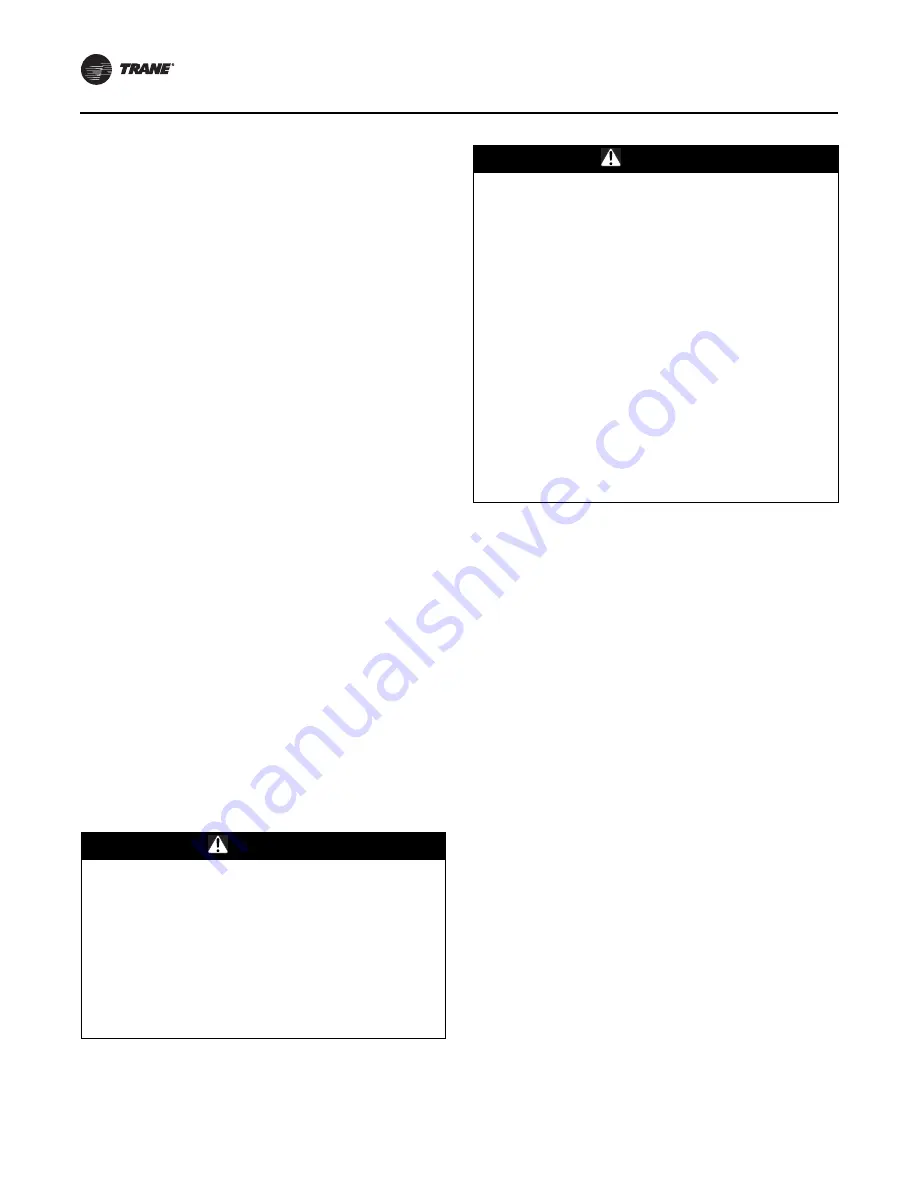
Installation Mechanical
14
ARTC-SVX002A-EN
Customer Responsibilities
Upon receipt of a chiller system, the customer must
conduct thorough internal and external inspections,
removing packaging material as needed for access to all
components.
Visible damage must be noted on the signed and dated bill
of lading. The customer may request a carrier inspection
by telephone or in person, but any such request should be
confirmed in writing. It is recommended that the customer
request that the carrier inspect the damage within 72
hours of notification.
The customer must store the chiller system in a dry, non-
corrosive, dust- and vibration-free environment due to the
exposure sensitivities of the microprocessor controllers
and to prevent electrical terminations from deteriorating
from non-use. Conditions in storage locations should not
fall below -20 °F (-29 °C) or exceed 150 °F (66 °C).
Components sealed in plastic shrink-wrap are not exempt
from these storage requirement. Moisture can potentially
collect inside the plastic film, resulting in corrosion of the
cabinet and electronic components. Any chiller system
packaging that is removed must be replaced with similar
protective covering as soon as possible.
Failure to adhere to these long-term storage requirements
may void the Trane warranty. Any component that is
damaged or inoperable due to improper storage may have
its warranty voided.
Handling of the Modules
The packaging from the factory permits lifting with a
suitable crane. Ensure straps are in good working
condition and that they are rated for the weight of the
machines. Spreader bars may be required for effective
rigging and to avoid damage to the chiller modules.
The chiller modules arrive fully charged with refrigerant.
As required under Federal regulations, installation, start-
up and service should be performed by fully-qualified,
factory-certified, personnel.
Site Preparation and Clearances
Chiller modules must be installed on a level surface that
has been checked by a qualified structural engineer to
support the weight of the fluid-filled modules and the
connective piping to and from the chiller. Installations
must account for minimum service access clearances as
may be practical or required by local building codes.
Chiller Clearances
The National Electric Code or local, state, and regional
building codes may require greater clearance for the
modular chiller than the figures listed in this publication.
Always consult local regulatory agencies to ensure
additional clearances are not required by building codes.
Minimum Clearances
The unit must maintain a minimum of 36 inch clearance on
all sides. See
Note:
These clearances are general recommendations.
Each installation has specific considerations.
Contact Trane for definitive guidance and approval
on a job-by-job basis.
Service Access
Compressors, filter-strainers, and liquid line shutoff valves
are accessible on each side or end of the unit.
WARNING
Proper Field Wiring and Grounding
Required!
Failure to follow code could result in death or serious
injury.
All field wiring MUST be performed by qualified
personnel. Improperly installed and grounded field
wiring poses FIRE and ELECTROCUTION hazards. To
avoid these hazards, you MUST follow requirements for
field wiring installation and grounding as described in
NEC and your local/state/national electrical codes.
WARNING
Electrical Shock, Explosion, or Arc Flash
Hazard!
Failure to follow these instructions could results in
death or serious injury.
Install the product in an appropriate electrical/fire
enclosure per local regulations. Do not install the
product in hazardous or classified locations.
Do not use the product for life or safety applications.
Do not exceed the product ratings or maximum limits.
Products rated only for basic insulation must be
installed on insulated conductors.
Current transformer secondaries (current mode) must
be shorted or connected to a burden at all times.
Unused openings for circuit breakers, switches and
wiring must be closed according to NEC requirements.
Remove all wire scraps, tools, replace all doors, covers
and protective devices before powering the equipment.





























